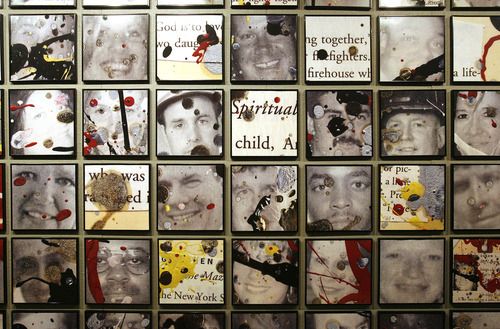This is an archived article that was published on sltrib.com in 2011, and information in the article may be outdated. It is provided only for personal research purposes and may not be reprinted.
When Frank McEntire visited New York two months after the 9/11 attacks, what impressed the artist most were the spontaneous memorials that popped up all over New York City to honor the nearly 3,000 victims.
"Everywhere there was a fence or a fire station, it seemed like someone had created a memorial with photographs, candles and written messages," McEntire says. He retained a visual memory of those makeshift monuments until 2004 when he unveiled his exhibit, "Spontaneous Memorial," which grows each year. It first appeared at Utah Valley University and has appeared annually since at venues in Utah and Idaho.
The latest, largest and perhaps last in the series is being exhibited at the Springville Museum of Art. "Each year, I add new elements," he says. "This year, the 10th anniversary, is a culmination for me."
McEntire acknowledges he may not have the psychic and emotional energy to continue "Spontaneous Memorial" after this year.
Unlike the thousands of memorials and remembrances that will be rolled out around the nation this week, McEntire's show goes beyond simply honoring the victims to ask hard questions.
One of the installations in the exhibition, "Fence," in fact, may be off-putting to many viewers. It's an 8-foot-square wire cube covered with price tags. Each morguelike toe tag recalls a victim of the attack and speaks to the difficulty of identifying bodies after the explosions and fires. It also questions the cost of a human life and the continuing cost of 9/11 to the nation. McEntire encourages viewers to write their thoughts on the tags. One says, "How could we ever forget the madness and sadness of this day? What a waste of life." On the back of the tag for victim Edward Beyea, someone wrote: "It happened while I ate breakfast."
Perhaps even more controversial is the fact that McEntire's cube is reminiscent of Mecca's Ka'aba, the most sacred site in Islam.
In another installation in the exhibit, the artist displays cards from the infamous "Most Wanted Iraqi" deck, which included Saddam Hussein and was distributed in 2003 to U.S. troops. The cards are arranged on a hymn board from an old Mormon chapel along with the posting for Hymn No. 331: "Oh, Say What Is Truth?"
McEntire says the work asks viewers to ponder the politics that linked 9/11 to Saddam Hussein and led to costly wars for the United States. "It's subtle, not hitting you over the head. But it's there," he says of the work's statement.
McEntire acknowledges the challenges behind creating an artwork that memorializes 9/11.
"Everyone is so sick and tired of [9/11 remembrances], but at the same time people's attention span is so short they need to be constantly reminded," he says. "In creating these works, I found myself wrestling with the ideas of exploitation, commercialization and privacy for the victims."
facebook.com/tribremix —
A contemporary artist remembers 9/11
Where • Springville Museum of Art, 126 E. 400 South
When • Through Oct. 14
Hours • Tuesday, Thursday, Friday, Saturday, 10 a.m. to 5 p.m.; Wednesday, 10 a.m. to 9 p.m.; Sunday, 3 to 6 p.m.
Info • 801-489-2727 or http://www.smofa.org
Admission • Free, but donations accepted











